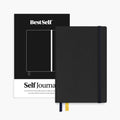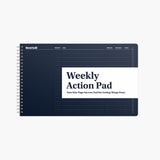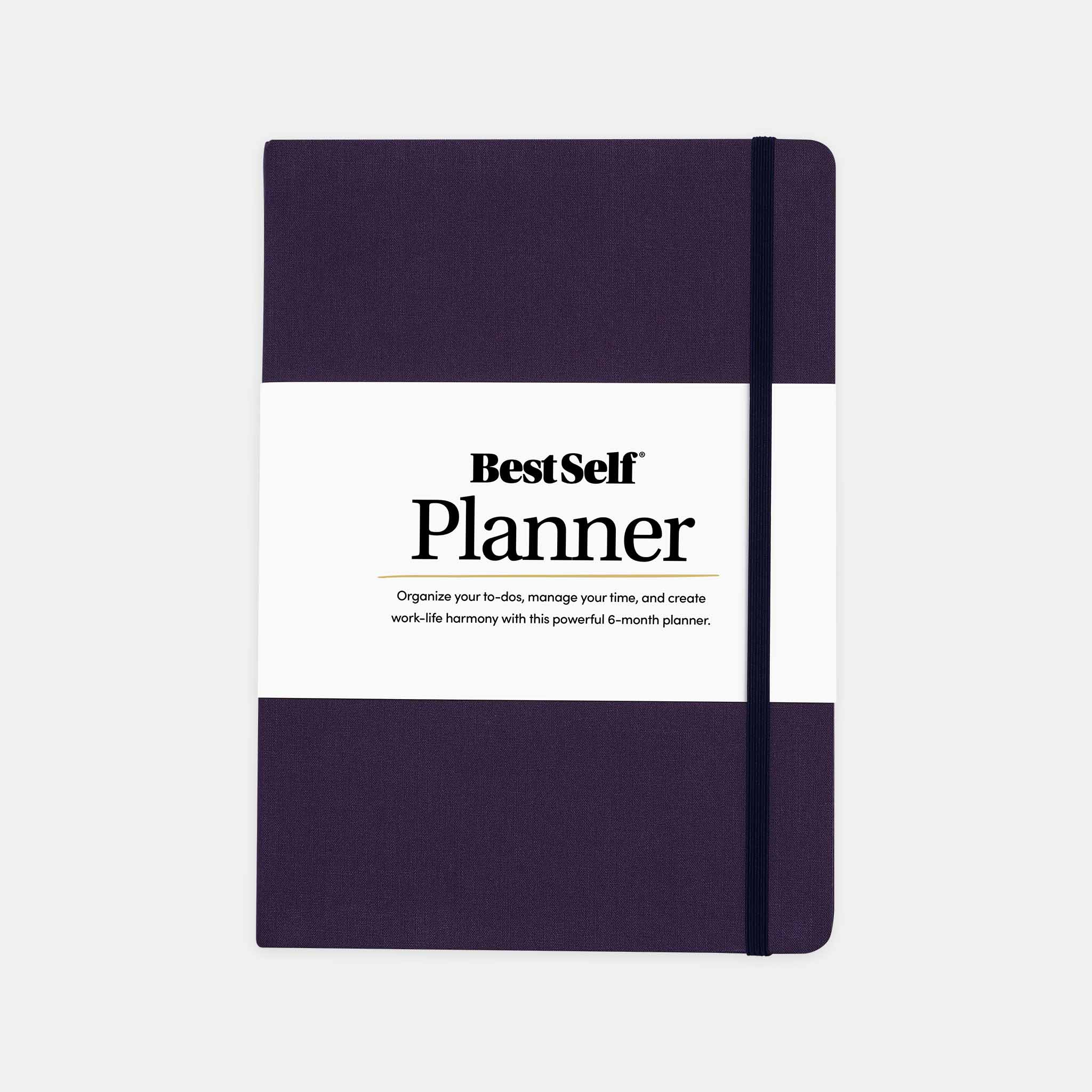By Georgina El Morshdy
The BuJo buzz is spreading! More and more people are turning a blank notebook into a powerful tool to get organized, juggle multiple balls, and take back control of their life. More in depth than a diary or calendar, you can use your bullet journal to track, plan, or schedule as little or as much as you like. But how to start a bullet journal in the first place?
In this detailed article, we’re going to take you step by step through the process of getting started so you can hit the ground running and take advantage of all the juicy benefits that bullet journaling offers you.
Let’s go!
What is a bullet journal?
OK, so let’s start at the absolute beginning. In case you’ve heard of bullet journaling, but aren’t entirely sure what a bullet journal actually is, here’s a quick definition.
A bullet journal is a combination of a diary/calendar/to-do list/planner/general organizer! Using bullet points as the core way of capturing and recording information, a bullet journal is a tool that helps you organize your life and get stuff done.
It differs from diaries, calendars, and other planners because you create your BuJo in a blank notebook. In other words, you’re not restricted by someone else’s methodology or layout - instead you’re free to create your own. It’s why bullet journaling is a big hit with creatives and artists as well as those who are productivity obsessed!
And best of all, it’s SUPER simple to get started. All you need is:
- An idea of what you want to track, measure, schedule, and plan
- A blank notebook
- And a pen
And then you’re good to go.
You don’t need to stop there. If you’re a stationery lover, then bullet journaling is a brilliant excuse to stock up on all sorts of accessories and tools including washi tape, stickers, and stencils. But you don’t need these to get started, that can come later as you find your flow and create your style.
Why start a bullet journal?
When you have too much to remember, too many things to do, and too many places you need to be, you can’t rely on your memory alone. The human brain is amazing. It can create, solve problems, and formulate ideas, but it’s not so good at remembering!
In fact, it takes a lot of bandwidth to remember stuff so if your head is full of memos and to-dos, you end up reducing the amount of space you have for everything else.
Far better to empty your head and get your life organized on paper so you can free up much needed headspace. But that’s not all… plan on paper and you can see your commitments and tasks reflected back at you. In turn, you can juggle things around and see the big picture without giving yourself a massive headache!
Bullet journaling also helps protect your sanity. When you’re juggling multiple roles and a ton of other commitments and tasks, it’s easy to get overloaded and overwhelmed. But with your BuJo to get you organized and scheduled, you can crack on with the task at hand - knowing you’ve got everything covered later.
This is how to start a bullet journal and get more done! There’s nothing more frustrating than feeling like you’re squandering time and falling behind because you’re forgetful or keep dropping the ball. A BuJo can help you keep it all together so you can crack on and live your best life.
In short, bullet journals are great for getting organized, boosting your productivity, and enhancing your performance. It helps you create work-life harmony too because when you plan for everything you can fit in everything.
There’s another angle too.
One of the things bullet journalers love most is the blank page - because it can become a-n-y-t-h-i-n-g. You’re not restricted by a particular layout or structure. Instead, you can create your own spreads to suit your particular lifestyle and goals. This creative aspect gives you freedom for doodling, hand lettering, stencils, stickers, and all sorts.
So unleash yourself onto the page and create something unique that works for you.
How to start a bullet journal - the essential spreads
Your bullet journal can track anything - the only limit is your imagination. I’ll share some ideas to inspire you a little later, but first let’s explore how to start a bullet journal by discussing the essentials.
1. Your MONTHLY spreads
2. Your WEEKLY spreads
3. Your DAILY spreads
If you’re using your bullet journal to get organized and increase your productivity, then you’ll want to plan your time at these three levels.
MONTHLY SPREADS

@planningroutine

@mabujork

@bahcampos

@oikawastudies
Use your monthly spread to create a big picture of your month. In this spread, you can capture:
● Appointments and meetings
● Deadlines
● Social or family commitments
● Key dates (such as birthdays or anniversaries)
● Courses, vacations, and days out
Put everything in one place to create an easy reference point. It’s a simple way to ensure you never double book yourself, take on too much, or forget to be in the right place at the right time.
Whenever a new commitment or request crops up, simply add it to your monthly spread - remembering to juggle things around if you need to.
Even better, have a few months on the go so you can plan further ahead.
WEEKLY SPREADS

© habitsbuzz.com

© thepetiteplanner.com
Next up are your weekly spreads. This is where you’ll create a big picture overview of your week.
It’s a cliche, but time is precious. There will be a lot of things you want to do, but maybe struggle to find the time. It’s not as if you’re sitting around twiddling your thumbs either! Instead, you’re always busy - juggling work, running around after your kids, and taking care of stuff in the home as well as trying to make more quality time just for you.
Your weekly pages can help you make the most of your minutes - so you can get more done in less time.
You have plenty of options for layouts. You can go super simple where you just create space for the days of the week.

Or you can create an organizer planner where you include features such as:
● Days of the week
● A list of priorities
● A to-do list
● A habit tracker
● A meal planner
● Health, wellness, and movement
● Self-care commitments

An organizer/planner works because it helps shape your thinking too. Instead of just lumping tasks to different days, you get to figure out your priorities and ensure you’re always working on the right stuff.
DAILY SPREADS
Now we come to my favorite part of how to start a bullet journal.
Before I started planning my day with a journal, I used a to-do list. It seemed to work. I enjoyed checking off completed tasks and I felt more organized knowing everything was written down. My problem was staying on top of that to-do list! Even when I was working full out, I’d still finish the day with too many tasks unfinished and untouched.
It didn’t feel good. I hated feeling behind and I found myself sacrificing more and more of my free time in an attempt to keep on top of it all.
Turns out it wasn’t my workload that was the problem. It was the way I was managing it.
Time is like money in the sense that you need to spend it within a budget. Instead of giving tasks an open ended time window, force yourself to get stricter with how long you expect each task to take. It’s the same with the tasks you do take on. Are you always working on the top priority task, or are you filling your day with stuff that keeps you busy but doesn’t make you productive?
My daily spread helps me set up my day for a win.
I still have a to-do list on the go, but I now schedule tasks in the same way I schedule meetings. That way I don’t knowingly overrun and I don’t set myself up to fail.
I also use my daily spreads to keep my goals top of mind and to figure out my priorities. It’s a powerful strategy that ensures you get all the important stuff done - without feeling overwhelmed or burned out.
Here are some suggestions for your daily spreads:

© forevergoodlife
● A daily timeline split into 30-minute sections - so you can get granular with your planning
● Free space - to write out your to-dos
● Note space - for jotting random ideas and reminders as they crop up
● Today’s targets - for getting clear on your priorities
● Space for errands
● Space for a daily gratitude practice
● Room to record your wins and successes
Don’t forget your index
Before long, your bullet journal is going to start to fill up. Your index will help you find everything quickly and easily. Simply number your pages as you go and make a note of what’s on each of them in your index.
And to cut down on writing, consider using a key as well.
From color-coding, to stickers, to hand drawn symbols, a key makes it easy to mark things in and join up the dots.
How to start a bullet journal - creative spreads
With the basic spreads covered, you can then allow your creativity to roam free.
You can turn those blank pages into ANYTHING that you want to track. Here are some examples to inspire you:
● Books to read
● Gratitude
● Goals
● Shopping lists
● Habit tracker
● Bucket list
● Braindump
● Savings tracker
● Review of the month/week/year
● Travel plans
● Meal planning
● Mood tracker
● Future log
How to start a bullet journal routine
We’ve looked at how to start a bullet journal, but how do you make this powerful practice a part of your life?
The more you put into your bullet journal the more you’re going to get out of it.
It’s true; bullet journaling is a flexible system that you can dip into whenever you like and whenever inspiration strikes.
But when it comes to your productivity and performance, you’ll get the best results if you BuJo daily.
This is where your routine comes in.
We recommend you plan your weekly spreads on a Sunday - as this will give you an edge for the week. Rather than wasting time on a Monday morning, you can hit the ground running.
If you can, plan your daily spreads the previous evening as this will give your subconscious mind time to process everything you’ve got coming up (ever noticed how you wake up with a solution to a problem you went to bed with?)
And for your creative spreads, you can dive in as and when you like - or whenever you get inspired to try something new.
The key is to find a system that works for you.
Play with it, explore it, and above all enjoy it! Get inspired by what other bullet journalers are doing too, but don’t allow yourself to get side-tracked or disheartened by all the beautiful spreads that you see.
If your practice helps enhance your life then that’s the right system for you.
Bullet journaling can be a game-changer. It’s a way to save your sanity, enhance your productivity, and boost your performance.
And now we’ve solved the problem of how to start a bullet journal in this article, you can get cracking. I promise you won’t regret your new habit for a second.





































